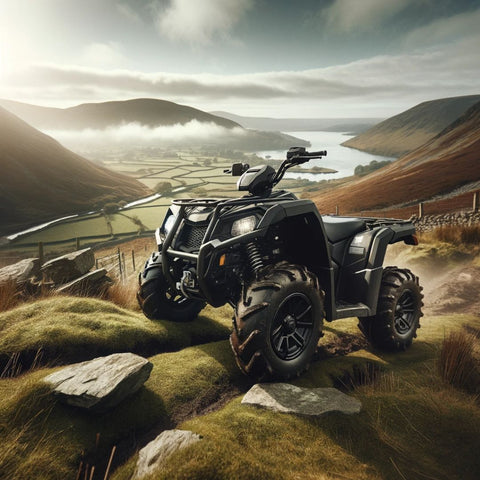
Ever zipped through a trail on a quad bike, feeling the wind against your face and the thrill of exploration coursing through your veins?
Quad biking is not just an exhilarating adventure; it's a way to connect with nature, challenge oneself, and enjoy the great outdoors.
But with great power (and speed) comes great responsibility.
Let’s dive into how we can share the trails responsibly, ensuring safety, preserving the environment, and keeping the peace with fellow trail enthusiasts.
Quad biking has exploded in popularity as a recreational activity.
It's thrilling, accessible, and a unique way to explore landscapes.
However, the fun of quad biking is only sustainable if we all play our part in using trails responsibly.
Let’s talk about why that matters.
Safety Guidelines
Safety Gear
First off, gearing up is non-negotiable. Helmets, goggles, gloves, and protective clothing aren’t just accessories; they’re essentials.
Think of them as your first line of defense against the unexpected.
Speed Limits
Speeding might give you a rush, but keeping it under control ensures everyone on the trail stays safe.
Plus, it gives you more time to enjoy the view!
Trail Conditions
Rain or shine, the condition of the trail can change your ride drastically.
A heads-up approach to varying terrains and weather conditions means you can adjust your ride to avoid accidents.
Pre-Ride Checklist
Before you even hit the trails, there’s a bit of homework to do.
A pre-ride checklist ensures your quad bike is in tip-top shape, and you’re fully prepared for the day ahead.
Check your fuel levels, tyre pressure, brakes, and lights.
Pack essentials like water, a map, a first-aid kit, and a toolset.
Ensuring you're prepared can make the difference between a great day out and a not-so-great one.
Environmental Conservation
Trail Preservation
Our trails wind through some pretty stunning natural habitats.
Staying on designated paths ensures that we’re not disturbing the local flora and fauna more than necessary.
Noise Pollution
Ever enjoyed the serene silence of nature, only to have it shattered by roaring engines?
Let’s keep our noise levels down, especially in sensitive areas, to preserve the tranquility of our natural surroundings.
Impact of Leaving No Trace
When we talk about environmental conservation, "Leave No Trace" is the golden rule.
This means taking all your rubbish with you, not leaving any parts or fluids on the trails, and avoiding activities that could lead to soil erosion or water contamination.
By leaving no trace, we ensure that the natural beauty and integrity of our trails are preserved for future riders and generations.
Trail Etiquette
Yielding
The trails are there for everyone - from hikers to bikers to equestrians.
Yielding the right of way when necessary keeps things friendly and safe for all.
Passing Protocol
Need to overtake someone?
A friendly heads-up and a wide berth make the process smoother and safer for everyone involved.
Group Riding
Riding in groups is part of the fun, but keeping a safe distance and communicating clearly with your fellow riders prevents mishaps.
Communicating with Other Trail Users
Trail etiquette isn't just about physical actions; it's also about how we communicate.
A friendly nod or wave to fellow trail users fosters a positive atmosphere.
If you’re approaching slower riders or need to pass, a polite verbal cue can prevent surprises.
Effective communication ensures that everyone’s experience on the trail is enjoyable and safe.
Respect for Others
Respect for Nature
It's not just about the ride; it's about the environment we ride in. Respecting wildlife and natural surroundings keeps the trails enjoyable for everyone.
Community Relations
Good relations with local residents and property owners can open up more trails for us to enjoy.
A little consideration goes a long way.
Sharing Trail Updates and Conditions
Got the scoop on trail conditions? Share it!
Whether it’s a quick post on a local forum or a heads-up to friends, sharing information about trail closures, maintenance, or weather conditions helps the community stay informed and safe.
Plus, it's a great way to show respect for both the trails and your fellow adventurers.
Legal and Regulatory Considerations
Licensing and Permits
Yep, there’s paperwork involved. Ensuring you have the right licenses and permits is part of being a responsible rider.
Trail Access
Not all trails are open for quad biking. Respecting trail access regulations means we can keep the ones we have open and maybe even gain a few more.
Understanding Local Wildlife Regulations
Each area has its own set of rules when it comes to wildlife.
Some trails may have restrictions during certain seasons to protect nesting areas or migration paths.
Familiarising yourself with these regulations can prevent accidental disturbances and ensure that we live in harmony with the local wildlife.
After all, it's their home we're riding through.
Education and Outreach
Training Programs
Think you’re a pro?
There’s always more to learn. Training programs can sharpen your skills and teach you a few new tricks about trail etiquette.
Community Involvement
Getting involved in local trail maintenance and advocacy isn’t just good karma; it’s a way to ensure our trails stay open and enjoyable for everyone.
Volunteer Opportunities and Trail Conservation
Love the trails? Consider giving back. Many areas have volunteer groups focused on trail maintenance and conservation efforts.
Participating in clean-up days, trail repair projects, or advocacy efforts not only helps preserve the trails but also strengthens the quad biking community.
Plus, it’s a rewarding experience that connects you deeper with the great outdoors.
Conclusion
Quad biking is more than a hobby; it’s a community, an adventure, and a responsibility.
As we zip through trails, let's remember the impact we have on the environment, on other trail users, and on the future of quad biking itself.
By following these guidelines, we ensure that the trails we love stay beautiful, accessible, and enjoyable for generations of riders to come.
So gear up, ride responsibly, and let’s share the trails respectfully.
FAQs
What should I do if I encounter wildlife on the trail while quad biking?
When you encounter wildlife on the trail, the best practice is to slow down or stop and maintain a safe distance. Never attempt to touch, feed, or startle the animals. Quietly wait for them to move off the trail. If the animal does not move, consider turning around and finding an alternate route. Remember, wildlife has the right of way, and it's our responsibility to ensure their habitat remains undisturbed by our activities.
How can I contribute to trail maintenance if I don't have time to volunteer?
Contributing to trail maintenance doesn't always require a physical presence. Consider donating to local organisations that support trail upkeep or participate in fundraisers dedicated to trail conservation. Advocacy is another powerful tool; speak up for the preservation of trails in community meetings, or support policies that protect natural areas. Every bit helps, even if you can't be there in person.
Are there specific signs or symbols I should be aware of while riding on shared trails?
Yes, shared trails often use specific signs and symbols to indicate rules, directions, or warnings. These can include symbols for yield, no entry, speed limits, and trail difficulty ratings. Familiarise yourself with these signs before heading out, as they're crucial for navigating trails safely and respecting shared use. Most local trail organisations or park services provide guides or maps that explain these symbols.
What steps should I take if I'm involved in or witness an accident on the trail?
If you're involved in or witness an accident, first ensure your safety and then assess the situation. If anyone is injured and you're trained in first aid, provide assistance within your capabilities. Always call emergency services for serious injuries. If possible, move to a safe location off the trail to avoid blocking it. After emergency services are contacted, notify trail authorities or park services about the accident. Remember, your response can significantly impact the outcome of an unexpected situation on the trail.
Get in Touch 🚀
Loved our article on “Quad Bike Trail Etiquette: Sharing the Trails Responsibly” Got the itch to dive into more wheely-awesome info?
Whether you're a parent or a grandparent, we're here for all your kids ride-on toy questions! 🚗💨
Feeling click-happy?
Jump straight into our wonderland at RiiRoo.com.
Or, if you're more the chatty type, give our Live Chat a whirl and let's talk toys!











Share:
Quad Bike Racing: How to Get Started in the Sport
21 Awesome Tips for Riding a Quad Bike in Winter